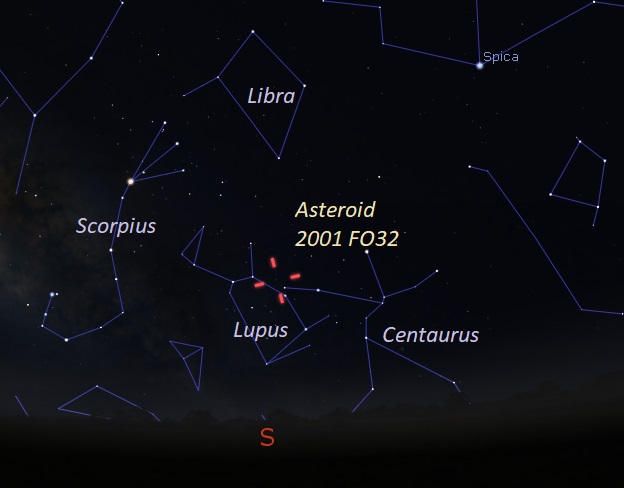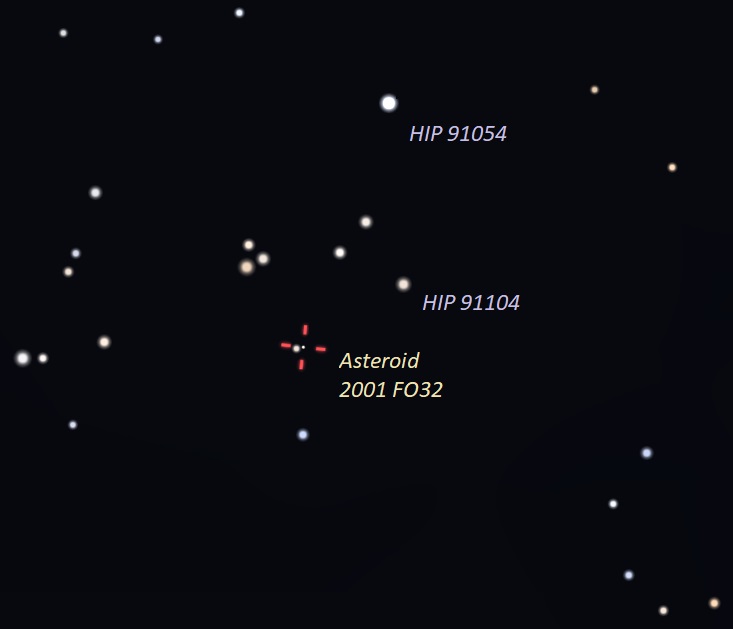The moving object coming from right (images above) is asteroid 2001 FO32, seen here just hours before closest approach to Earth on March 21, 2021. The bright star in the lower left corner is HIP 90904, a star of magnitude 7. Images were taken with a 10″ (25cm) S/C Telescope at 9:27 UT / 5:27 ET from Añasco, Puerto Rico, by Eddie Irizarry.
Update 3/21/2021: Asteroid 2001 FO32 appeared in our skies slightly brighter than expected. A comparison with background stars suggest the space rock was at closest approach as bright as a 9 to 9.5 magnitude star, instead of the expected 11 magnitude.
The biggest known asteroid to pass in 2021 will sweep by on March 21. Asteroid 2001 FO32 is estimated to be about .6 miles (1 km) in diameter, not quite as long as the Golden Gate Bridge, but comparable in length. Although there’s no risk of impact, the space rock is of interest also because it’s one of the fastest space rocks known to fly by Earth. It’s traveling at about 76,980 miles per hour (123,887 km/h) or 21 miles (34.4 km) per second, relative to Earth. In contrast, Earth travels around the sun at about 18 miles (30 km) per second. Since 2001 FO32 is good-sized and occasionally passes near Earth, it’s been classified as a Potentially Hazardous Asteroid. Its orbit is well known, though, and it poses no risk of impact now or for centuries to come. On the contrary, astronomers are excited about the asteroid, which, NASA has said will provide them with:
… a rare opportunity to get a good look at a rocky relic that formed at the dawn of our solar system.
On March 21, 2021, FO32’s closest approach to Earth will occur at 16:03 UTC; translate UTC to your time. At its closest, it’ll be about 1.25 million miles away (2 million km) – or 5.25 times the distance from Earth to the moon. SpaceReference.org reported:
Based on its brightness and the way it reflects light, 2001 FO32 is probably between 0.767 to 1.714 kilometers (.5 miles to 1 mi) in diameter, making it larger than ~97% of asteroids but small compared to large asteroids.
A fascinating aspect of asteroids is that observers using backyard telescopes can spot them as apparently slow-moving “stars.” It typically takes at least 5 to 10 minutes for backyard telescope users to detect a space rock’s motion in front of its starfield. But asteroid 2001 FO32 will be sweeping past Earth at such a fast pace that, when it’s closest, observers using 8-inch or larger telescopes might be able to detect its motion – its drift in front of the stars – in real time.
We note that the space rock will be too faint to see wth the unaided eye. It’ll be visible to observers using 8-inch or larger diameter telescopes. You must aim your telescope at the correct position in the sky, at the right time. The charts in this post provide details. You might also check Stellarium online or TheSkyLive for more details on observing.
One caveat for northern observers. The asteroid is placed relatively low in the southern sky. As asteroid 2001 FO32 passes by Earth, observers using telescopes might try to spot it as it glides through the southern constellations of Scorpius and Sagittarius. For observers in the southern U.S., the asteroid will be low in the sky, above the southern horizon (about 20 degrees or lower), just before dawn on March 21, 2021. Observers at lower latitudes and in the southern hemisphere will be better placed to take a look through a telescope.
After it passes by Earth in March 2021, the next encounter of this asteroid with our planet occurs in 31 years, on March 22, 2052. However, the 2021 approach will be its closest to Earth for the next 200 years for which its orbit has been calculated.
Asteroid 2001 FO32 was discovered on March 23, 2001, by the Lincoln Near-Earth Asteroid Research (LINEAR) project, near Socorro, New Mexico.
The space rock’s orbit carries it around the sun every 810 days (2.22 years). It comes as close to the sun as 0.30 astronomical units (1 AU = 1 Earth-sun distance). It travels as far from the sun as 3.11 AU. Its orbit is highly elliptical (as opposed to being closer to circular).





How fast did Asteroid 2001 FO32 appeared at the eyepiece or monitor using a telescope? Take a look at this video taken just before sunrise on March 21, 2021, by Eddie Irizarry:
Bottom line: Asteroid 2001 FO32 is the biggest known asteroid to sweep past Earth in the year 2021. It will fly by at such a fast pace that, when it’s closest, observers using telescopes might be able to detect its motion – its drift in front of the stars – in real time.











